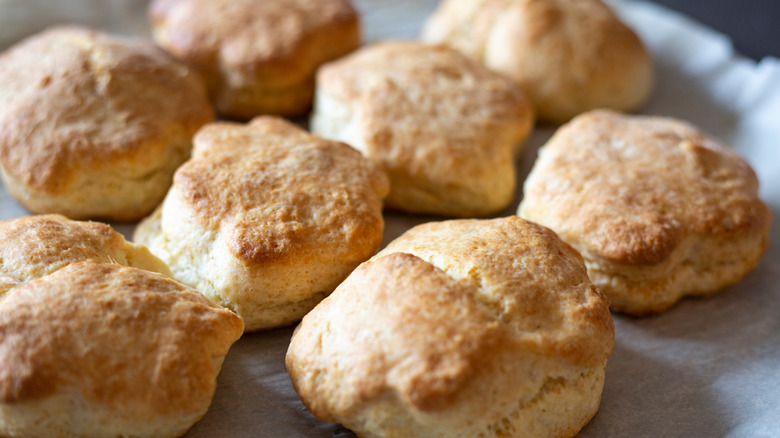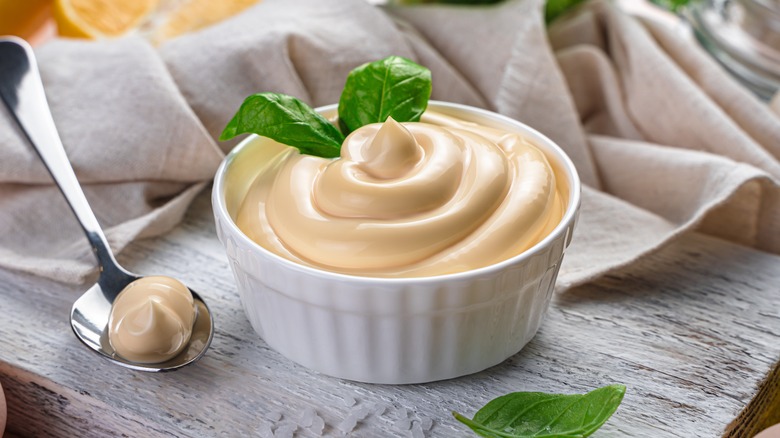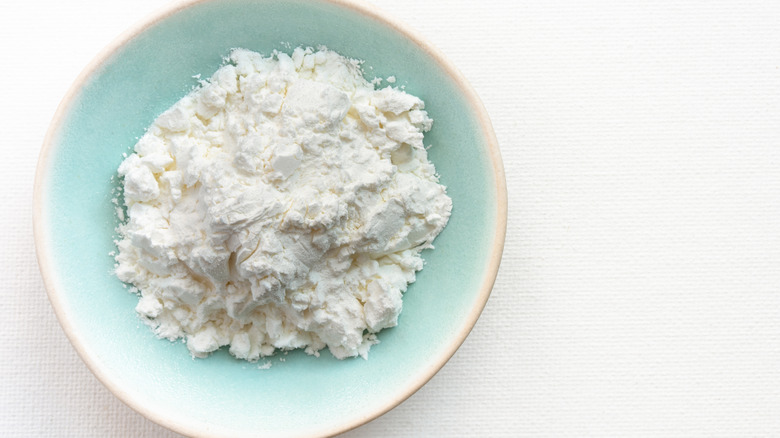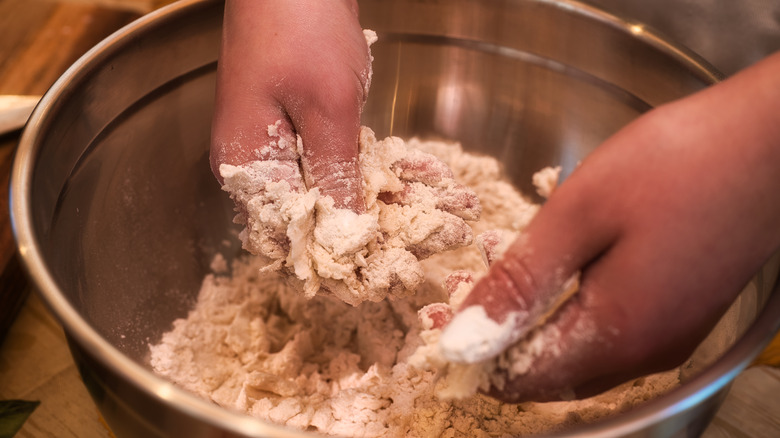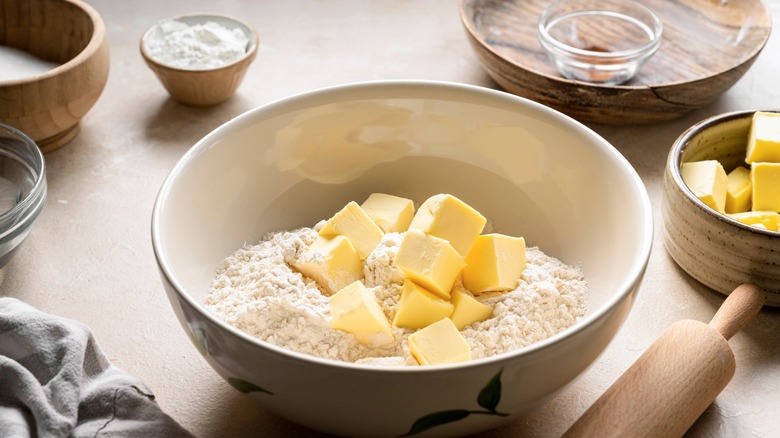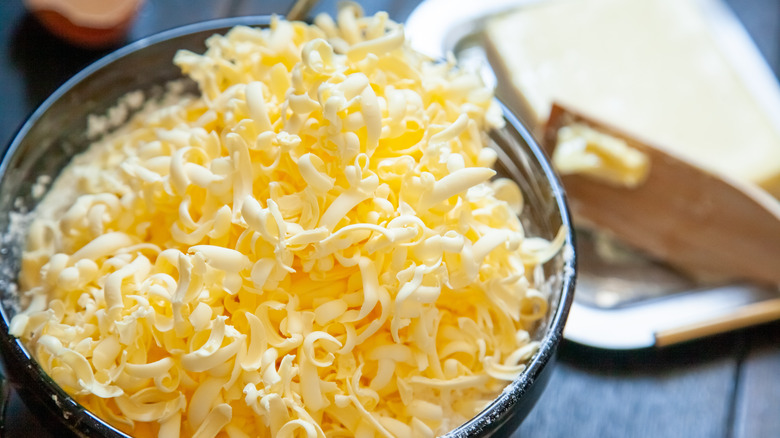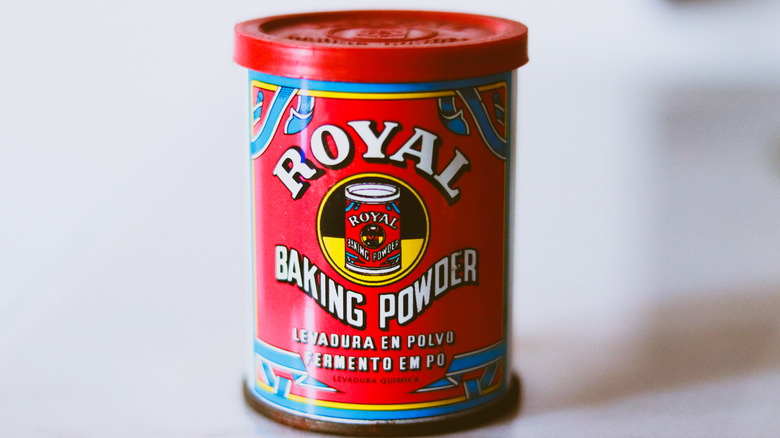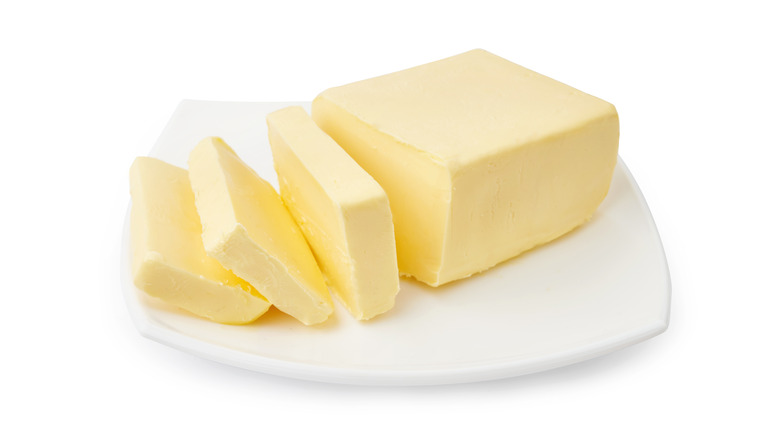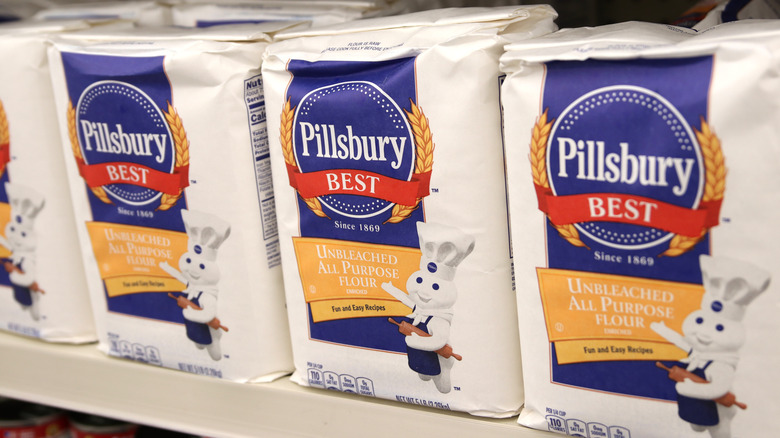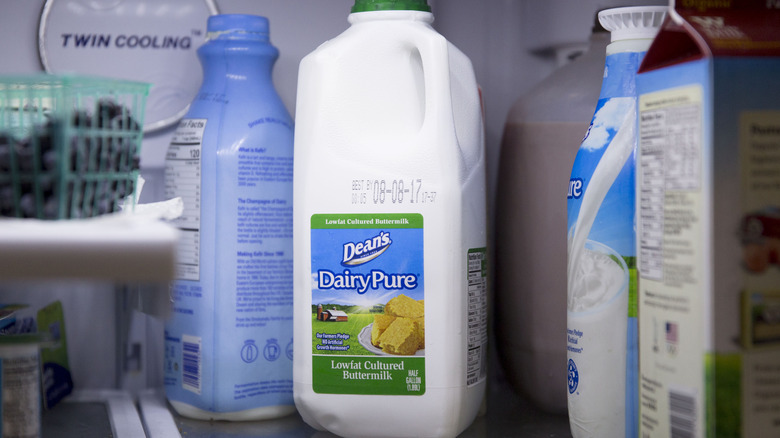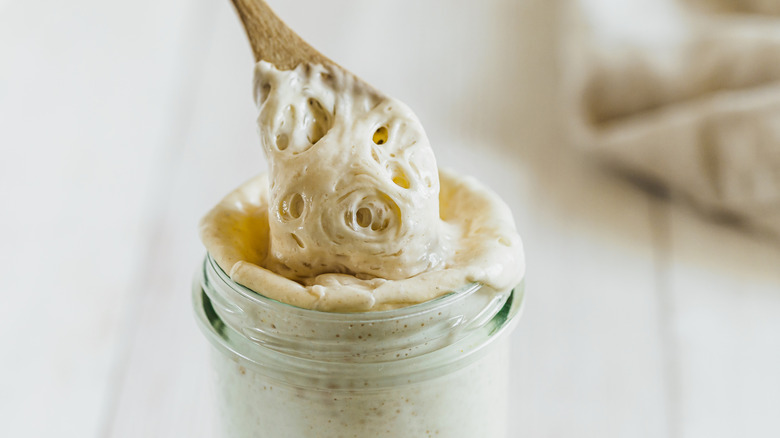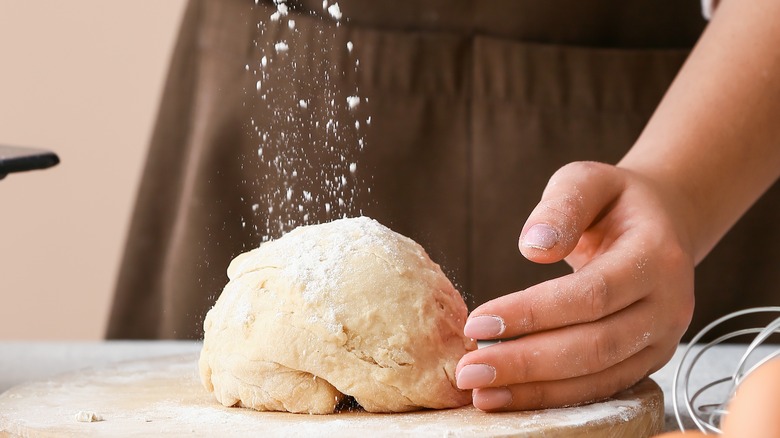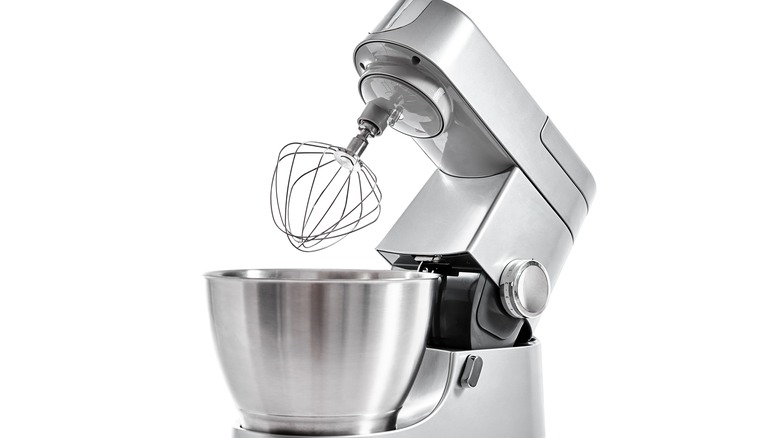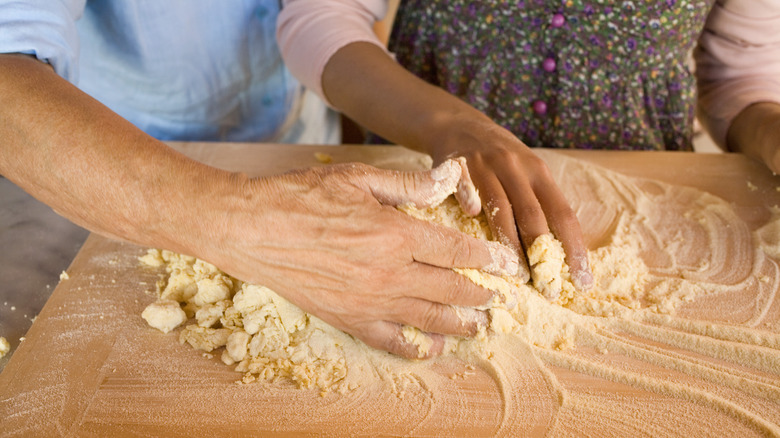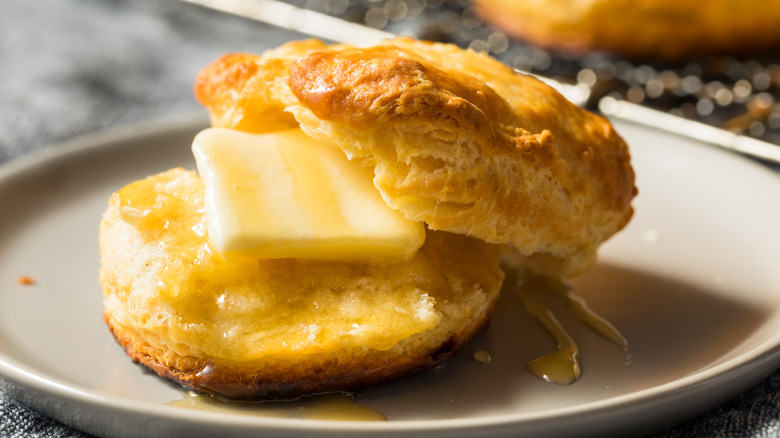14 Ways You're Ruining Your Biscuit Dough
Whether you like to eat biscuits with sausage and gravy or with a schmear of butter and jam, you likely can't help but profess your love for the plush, layered breakfast delight. Biscuits had their humble beginnings in Europe; the name "biscuit" is derived from the Latin word for "panis biscoctus" meaning "twice baked" (via HowStuffWorks). In the antebellum South, biscuits had very little resemblance to the tall leavened ones we think of now — they were thin, flat, and only eaten in wealthy homes with access to pricey flour. Beaten biscuits came later; this iteration had butter or lard for fat with no means to expand its dough. Innovations in the 19th century led to efficient flour mills and the introduction of leavening agents like pearl ash, potassium bicarbonate, and sodium bicarbonate (or baking soda).
Despite all of these modern advancements in biscuit-making technology, everyone has at least one bad experience with creating the baked good— whether they deflate, come out like a brick, or just don't taste right. Here are some tips for improving biscuit dough for perfect layers and flavors every time.
Forgetting to add mayonnaise for a soft crumb
Mayonnaise likely isn't your go-to addition for smooth buttermilk biscuits, but biscuit dough can actually benefit from the additional moisture from a scoop of it. The popular condiment is made from a few ingredients often used in baking, such as eggs, oil, and vinegar. Some recipes will require the additional acid that can come from buttermilk or vinegar, while others will cover these bases with mayonnaise alone. When making biscuits, the acid helps tenderize some of the starches and proteins in the flour, and when combined with alkaline leavening agents like baking powder, the dough is able to rise (via Busby's Bakery).
Mayonnaise biscuits are a different kind of baked good than your traditional roll-out biscuits. Since the condiment causes the dough to be compact and plush, these biscuits can be easily dropped onto a baking sheet or into a muffin tin.
Omitting cornstarch
Cornstarch might not be in every biscuit recipe, but it really should be. The ingredient increases the tenderness of a Southern biscuit because it softens the proteins in the flour (via Bob's Red Mill). If the gluten in the flour is too rigid, you'll find that the texture of the biscuit ends up very stodgy and hard to bite into. Unlike when a cornstarch slurry is needed to add to a sauce as a thickener, you can add the cornstarch directly to your dry ingredients. If you don't have this item handy, you can substitute equal parts flour instead.
Cornstarch is made from the endosperm of corn. The starch is white and virtually flavorless, but it can play a very important role in thickening pie filling, puddings, and soups. Bob's Red Mill notes that you may also see the ingredient used as an anti-caking agent in processed and packaged foods.
Using the wrong type of fat
The perfect biscuit finds a middle ground in texture, flavor, and fat. Depending on your recipe, you may not have the right type of fat to get the ideal consistency. While moisture is important in getting the quintessential biscuit puff, it is also important to prioritize a high-fat ingredient to get the perfect shape and appearance.
Most biscuit recipes utilize butter as the primary fat — some of which require close to a pound of butter — for a good reason. According to King Arthur Baking Company, butter may produce the highest rise among the fat sources available. It also creates the best color because of the presence of milk solids; when heated, they begin to change color to an appetizing golden brown.
However, King Arthur Baking Company notes that you can use other fat sources to craft the perfect biscuit. The brand's baking tests found that shortening placed second best in color and height, followed by coconut oil and lard, respectively. Though, if you want to stick to traditional butter, keep in mind that certain types with higher fat content, such as Irish or European-style butter, do not have the same moisture content as standard American sweet cream butter. This makes American butter the ideal choice when it comes to baking biscuits.
Not using enough fat
Not only is the type of fat important, but so is how much you use for your recipe. If your biscuits are crumbling and your dough isn't sticking together, it likely indicates that you are not using enough fat to bind your ingredients. If you are using margarine or shortening instead of butter, you should check and make sure you're using a substitute with at least 70% fat. You'll also want to ensure that you thoroughly mix the fat throughout the dough, but avoid grating the dough down too much so that the fat doesn't seal around the flour particles.
If you don't want to add more fat to your recipe, you may have to adjust the ratio to decrease the volume of dry ingredients used in your biscuit recipe. This tip will keep your biscuits soft and buttery without having to go to the grocery store to pick up another pound of butter.
Adding butter in chunks rather than grating it
The butter distribution in your recipe is key to ensuring that your biscuits have an even, puffy rising experience. To achieve the perfect fat distribution and mix throughout your dough, use a box grater instead of cutting your butter into small chunks with a knife. This creates smaller, more manageable pieces that are easily blended with the other ingredients.
However, when making biscuits with this hack, you'll want to ensure the butter is frozen before you start shredding it; it's often recommended that you keep it in the freezer overnight before baking day. This ensures that the heat of your hands won't cause a significant amount of melting as you grate it. Additionally, keeping the fat as cold as possible prevents your biscuits from "splatting" when they hit the heat of your oven. Once the chilled butter starts to melt in the oven, it releases steam, resulting in flaky layers.
Not using enough leavening
Leavening is another factor in causing a perfect biscuit puff. Baking soda and baking powder are the two most common leavening agents used in biscuits. Baking powder contains both sodium bicarbonate (the chemical name for baking soda), as well as cream of tartar. It can be used alone in a recipe because it contains both an acid and sodium bicarbonate — it just needs a bit of moisture to kickstart the reaction to release the carbon dioxide. King Arthur Baking Company recommends combining ½ teaspoon baking powder with two tablespoons of warm water. (If foam doesn't form after this, it indicates you need fresher baking powder.) If you choose to use baking soda, you need an acid, such as buttermilk or vinegar, to activate it.
However, baking powder is more often used in biscuit recipes because it allows the acidic ingredients, like the buttermilk, to be used as a tenderizer and a flavoring agent rather than just a chemical activator that loses many of its qualities when it meets the sodium bicarbonate. Substituting baking soda for baking powder will often result in major issues in the texture and flavor of your biscuit.
Letting your dough mix get too warm
We've already established that a good biscuit requires cold, hard butter, but if you want the perfect dough for this, you'll need to keep the dough as cold as possible at all times.
Besides using frozen butter from the start, you should take an extra step to keep it cold by chilling the biscuit dough between rolling and shaping, similar to cookie dough. King Arthur Baking Company notes that overworking the mix with your hands transfers heat into it, which warms up the butter and causes it to melt.
Also, before you bake your biscuits, you should place the shaped biscuits on the tray in the refrigerator for between 20 and 30 minutes to ensure that the butter has enough time to harden. This period also allows the gluten to slack, which results in a softer and more delicate structure. After all, it just gives you more time to make your sausage gravy.
Using plain flour and self-rising flour interchangeably
If you've spent any time in the biscuit world, you've probably heard the name "White Lily" thrown around. It is a popular brand of flour made from soft winter wheat. It is lower in protein than all-purpose flour, meaning that it will have a more delicate crumb structure that isn't as chewy as what a standard flour would produce.
You may also see some biscuit recipes made with self-rising flour. These simple, two-ingredient baked goods are made with only cream and self-rising flour. The cream plays an important role: adding moisture and fat to the dough. The self-rising flour comprises standard flour in addition to a leavening agent and salt mixed into it. Therefore, if you make a biscuit recipe that calls for all-purpose flour instead of self-rising flour, you'll need to make sure you add leavening to compensate. However, there could be detrimental consequences if you use too much leavening agent in your dough.
Not using buttermilk
There's a reason why buttermilk and biscuits have a timeless relationship. Buttermilk is a by-product of making butter and tastes similar to tangy yogurt but is thicker in consistency than regular milk. It's made with pasteurized, cultured milk and lactic acid, giving biscuits flavor and structure. The ingredient first appeared in recipes in the mid-20th century when Church & Co. (soon to be known as Arm & Hammer) introduced baking soda to home cooks across America. However, the sodium bicarbonate needed acid to produce the carbon dioxide required to give the biscuits their rise.
If you are adding buttermilk to your biscuit dough, you'll want to stick to using the store-bought version rather than making your own with sour milk (via Southern Living). This is because the store-bought variety is thicker, tangier, and more flavorfully acidic than just using sour milk. You can also purchase buttermilk in different fat levels, including low- and full-fat — Southern Living notes that the low-fat option is most common at the grocery store and suitable for biscuit recipes.
Using sourdough discard for more flavor
Anyone who has worked with a sourdough starter knows how arduous it can be to find a use for the remains when it's time to discard and re-feed it. One of the best uses for your leftover starter is to flavor your baked goods. If you want to amplify the sourdough flavor in your biscuits, you should refrain from feeding your starter for a longer period; this will cultivate a stronger taste. You'll also need to use a whole cup of discard for each cup of flour you use in your recipe.
Since sourdough bread recipes are proofed for hours at a time, the wild yeast in the sourdough has a lot of time to proof and subsequently causes the bread to rise. However, even though you might add sourdough to your biscuits, you should still focus on baking powder as the primary leavening agent.
Overworking your dough
Gluten is a very fragile and easily overworked part of any baked good. Some gluten formation is important to give the mixture its structure and shape. But, activating the gluten in the dough too much may create major issues in how much give the biscuits have when you bite into them.
Travis Daniel Bow recommends kneading your biscuit dough at least five times and potentially up to 15 times. The author's baking experiment revealed that biscuits kneaded less than this did not hold together as well as those kneaded more. The biscuits that were folded more had higher rises and were cleaner to split than the under-folded ones. If you're working with your dough and it becomes rigid or difficult to form, it could indicate that it is overworked. In this case, try placing the dough into your fridge to soften the gluten before you bake it.
Using a stand mixer to mix your dough
Your stand mixer is a catch-all for baking and cooking in the kitchen. But you should avoid using the appliance to make your biscuits. Even if you opt for a bread hook over a paddle attachment for the device, you'll find that the dough can be easily overworked with the sheer speed and power of the stand mixer.
Cook's Illustrated instead recommends using a food processor to distribute the fat throughout your dough with the pulse setting. Simply add the fat to your dry ingredients and pulse until the mixture forms a rough meal. You'll need to transfer the dough out of the food processor before you can add your liquid components. (If you add them to the processor directly, you risk the dough overmixing and becoming too stodgy.) Use a spatula to incorporate the liquid throughout the dough until it reaches a doughy consistency.
Not keeping your dough shaggy
Have you ever heard dough being described as "shaggy?" It's definitely unlike your thin, clean-rolled cookie dough around the holidays. Shaggy dough is bumpy, irregular, and not always pretty to look at. According to King Arthur Baking Company, this is what you'll often see at the preliminary stage of mixing before the dough finally develops; there is very little gluten formation, and it is not elastic. Once it's kneaded, folded, and turned, the gluten develops, and the dough takes on a smoother appearance.
You should stick to the rough dough for your biscuits to prevent overworking and over-activating the gluten. Although a lumpy mix is ideal, you should be sure that there are no dry spots or pockets of flour left over. Not only is the result unsettling when you bite into a biscuit and are met with a ball of dryness rather than the plushness of a perfect baked good, but leaving bits of flour may also create major issues for the rising and layering of your finished product.
Not taking advantage of simplified biscuit recipes
As home cooks, we tend to overcomplicate things. If you are a novice biscuit maker, you should start simple and try making three-ingredient biscuits with self-rising flour, butter, and buttermilk. These can come together with only a few minutes of your time and a food processor. After your dough has come together, you can layer it on a flat surface and cut it into rounds or small wedges if you prefer.
And with all the time you'll have on your hands, you can focus on what kind of toppings and spreads you'll add to your biscuits. Sweet toppings like spiced honey butter and jam are great for afternoon tea or breakfast. You can also make a savory breakfast with eggs, cheese, and your favorite breakfast meat. If you have leftover biscuits, you can store them in an airtight container for up to a few days.
